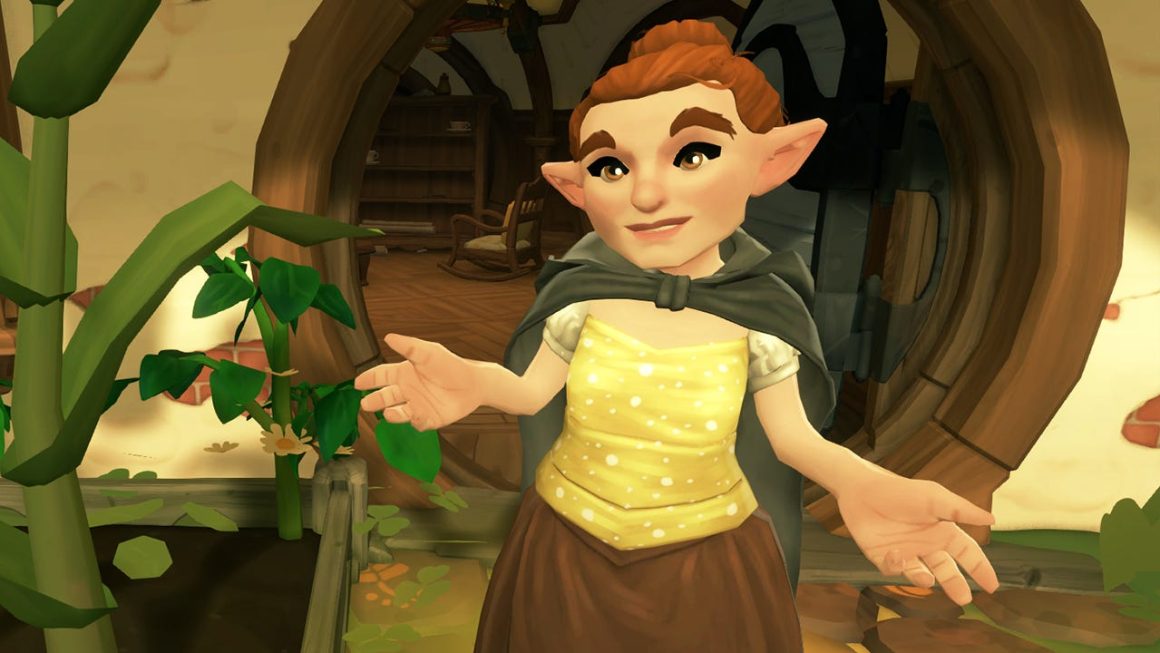The most devastating part about Tales of the Shire: A The Lord of the Rings Game is just how short it falls of fulfilling such an insanely promising premise. I mean, which Tolkien nerd among us hasn’t daydreamed about living a relaxing life as a halfling? But instead of the warmth and comfort of the Shire, I spent 25 hours feeling like I was marching through the Dead Marshes in this cozy misadventure. It’s regrettably dull from start to finish, and runs so badly I wasn’t even allowed to be bored out of my mind in peace. The barebones life sim mechanics offer some of the most shallow versions of classic activities like fishing and farming that we’ve seen done much better in dozens of other games, and building social links with the inhabitants of Bywater is monotonous, repetitive, and never worth the effort. There’s at least some humorous writing and fun moments here and there, and the cooking minigame that serves as the main progression activity thankfully has slightly more depth than the other chores you do, but the few bright spots that exist are drowned out by one of the most disappointing cozy games I played since the Second Age. I went into Tales of the Shire thinking I’d be as happy as Denethor seeing Boromir, but I got Faramir instead.
Though it rarely succeeds in the attempt, Tales of the Shire mostly follows the blueprint of games like Animal Crossing and Disney Dreamlight Valley, with stress-free slice of life activities in a quiet village as the main draw. You’ll try your hand at lesser versions of the usual fishing, gardening, and cooking minigames as you improve your relationships with your fellow townsfolk – all wrapped in a Tolkien skin that plays with the characters and locations found in The Lord of the Rings. The minimalistic story puts you in the hairy feet of a hobbit who’s recently moved to Bywater and begins to establish themself in the community, all while fixing up the rundown hobbit hole you’re given. You’ll meet some recognizable characters like Gandalf and Rosie Cotton and run samey errands for your neighbors in an attempt to get Bywater officially recognized as a village. As is often the case with games like this, it’s not much of a story, but has some likeable characters and amusing moments here and there as the goofy cast of hobbits bicker and squabble over trivial things that only a hobbit would bother caring about. Unfortunately, a complete absence of voice acting inhibits this high point; it just never quite felt right for such colorful and well-known characters to be completely silent throughout the story’s roughly 15-hour runtime.
One of the great things about the life sim genre is that, although they can appear fairly superficial at first, the longer you play, the more you discover hidden layers of depth to get completely lost in. Unfortunately, Tales lacks this essential component. At the point where I’d usually expect to enter an impossible-to-put-down chain of easygoing activities as I build out a quiet, virtual life for myself, it instead had me scratching my head as to what the point of all the monotonous busywork they’d saddled me with even was. That’s mainly because, despite featuring lots of cooking, Tales has very little meat on the bones for the vast majority of its mechanics, like how the best way to make money is to slowly walk back and forth across the very small map, picking up the same very small handful of foragable goods, then selling them so you can buy a single cut of bacon to use in cooking. The only time anything changes is when the seasons shift every dozen or so in-game days and you get a few new ingredients to find and crops to plant, but there’s a whole heck of a lot of tiresome grinding in between those shifts, which ultimately only alter the ingredients you’re collecting and the look of the village anyway.
Nearly every activity you’re expected to grind, from fishing to gardening, suffers from this same infuriating lack of depth. For example, you can only fish in a few spots around the map, and doing so yields the same very small handful of fish with little to augment or evolve your angling over time. When I unlocked my first fishing rod upgrade after completing numerous fishing-based quests, I was hopeful this would expand the number of fishing holes accessible to me or let me catch a whole new roster of sea creatures, but only moments later those hopes were dashed as I returned to the same places and caught the exact same fish I’d been reeling in for hours. And since you’re given tons of humdrum quests that require quite a lot of fishing to complete, you’re subjected to a whole lot of tedious repetition with very little in the way of payoff.
Really the only exception is the cooking minigame, which serves as the main activity that all the others seem built to support and is much more substantial as a result. Fishing, foraging, gardening, taking care of chickens, and buying ingredients are all just a means to an end for your ever-hungry hobbit, and all of the components you gather are brought back to your home to combine into a dish you’ll then use to curry favor with other hobbits. You’re able to invite a few of your neighbors to share a meal with you once per in-game day, and after learning their preferences and cravings, you’ll have to mix together the right combination of flavors to maximize how much your cooking causes them to like you. Doing so levels up your social links, which awards ingredients and new recipes that open up new possibilities, and even occasionally result in a short conversation between you and whichever hobbit you’ve charmed – a decent payoff to your investment in a game that doesn’t respect your time in most other areas.
To be clear, Tales still doesn’t really nail this minigame either, as the actual game part isn’t very good and is overly simplistic, especially in the first dozen or so hours before you unlock additional cooking tools that add a tad more nuance to the process. For example, unlocking the sauce pan allows you to stir different seasonings into your dishes that augment the flavor profile. Plus, you’re required to take on a ton of very boring chores just to get the ingredients you need, and then there’s a good chance you’ll just be waiting around for the next day to come before you can invite new people, since there are so few things to do aside from the time-gated meals. But cooking and the social elements it triggers are at least a relative highlight in a life sim that is so consistently underwhelming, and it does evolve over time in a way that the other activities don’t.
Beyond the grind of gathering ingredients, cooking meals, and feeding them to the residents of Bywater, you’ll also improve and decorate your little slice of the Shire. The home you’re given is pretty rundown at the outset, but is expanded and fixed up as you complete activities, the most important of which is the ability to raise chickens that generate eggs and gain access to more farm space. Unfortunately, although it’s nice to have more room and other small improvements like an actual working front door that takes way too long to unlock, there’s not a lot of interesting things to do with the additional space you’re given indoors. You gradually unlock decorations by completing quests, but there isn’t a ton of variety to them, zero functionality to adding things like new shelves and whatnot, and the entire layout of your home is static, so you have to just work around an existing floorplan that doesn’t offer much room for expression. This means that yet another component that’s usually a major draw in life sim games feels like only the minimum amount of effort was put into it. The good news is that the home you’re given definitely nails the Shire aesthetic when it’s fully upgraded, and even if there’s not many exciting options for personalization, it at least gets the job done when it comes to fulfilling part of the hobbit fantasy.
Even if Tales of the Shire were a more interesting game than it is, it would still be pretty hard to play purely by how unacceptably bad it runs. With constant framerate hitches, pop-in, aliasing, hard crashes, and other wonky stuff that suddenly broke, I never went more than a few minutes without something going terribly wrong. The worst of it was the consistent and repeated crashes throughout my play time that forced me back to my desktop, resulting in half an hour of lost progress as I had to start the entire day over. This often happened right after I completed sharing a meal with my halfling homeys, which requires quite a bit of prep work and planning, making it just about the worst time for a crash to happen. At one point I repeated a single day five times (totaling several hours of game time), with a crash happening at the end of the day each time, to the point where I wondered if I’d permanently broken something and wouldn’t be able to progress any further.
The rest of the issues, like how inconsistent the framerate is and how objects pop up right in front of your face, are more confusing than anything else – I mean, this does not seem like a particularly demanding game and I played on a high-end PC. It’s such a bummer, specifically because the painterly art style and iconic setting of the Shire has so much potential, and almost none of that comes through when you’re seeing shrubbery pop up right in front of you as you walk around town. Then there’s the one-off bugs, like one time where my fishing line stayed in the water when I was done fishing, and it wouldn’t let me put away my rod, so I walked around Bywater with a hilariously long fishing line stretching across the entire map.
I also tried out a little bit of the Switch version and, well, let’s just say that I’d have to write a whole separate review to talk about how especially awful of an experience that was. It’s worth mentioning that near the tailend of my time with Tales of the Shire, there was an update that did improve some of the framerate issues slightly, so there’s at least hope that it will run better in the future after some patching up. But even after the most recent update, it still doesn’t run great.



